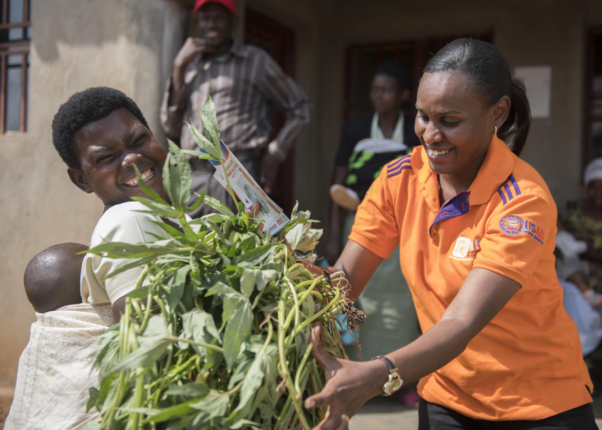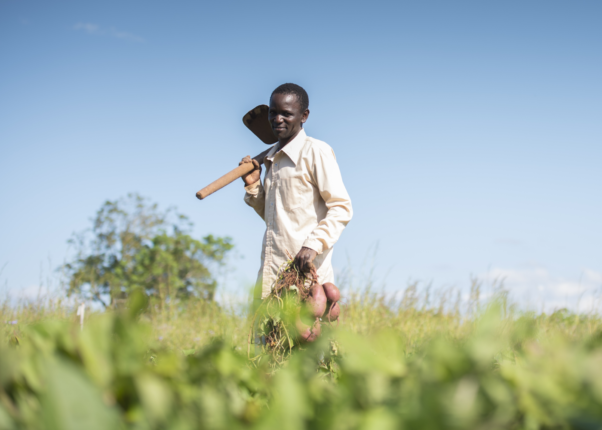
Kwame Ogero is a seed systems specialist working for the Sweetpotato Genetic Advancement and Innovative Seed Systems (Sweet GAINS) project in Tanzania. Regional Communications Specialist Vivian Atakos spoke with Ogero about the innovations taking place during the last stages to accelerate and streamline the process of getting improved varieties of sweetpotato into farmers hands.
Q: Seeds are vital to farmer productivity can you share with us some of the obstacles that farmers face in accessing quality seed.
Kwame Ogero (KO): For a long time, there has been a disconnect between farmers and upstream sources of quality seed, either because farmers are not aware of those sources or the distances between the two are huge— a research station producing quality seed might be 200 kilometers away from beneficiary farmers. We also have the challenge of farmers not being aware of the benefits of quality seed especially in terms of increasing yield, or of the new improved varieties coming out of the research pipeline. Therefore, farmers keep recycling what they have even when it’s already infected with diseases.
Q: When they use infected materials what does this mean for their crop productivity?
KO: If you cut a vine from an infected plant and use it as your planting material for the next season then you’ve actually transferred that disease and you’re enabling the virus to build up within the plant. Overtime you’ll see a consistent decline in tons per acreage.

Q: That brings me to the mission of the International Potato Center… it is dedicated to developing improved varieties of sweetpotato. Why is it important to breed varieties that are suited to local preferences and conditions?
KO: There are two key reasons, the first one is climate and the second is farmer preferences. Different places have different climatic conditions including rain patterns, humidity, temperature and all of these, affect how the crop is going to grow. Secondly, consumer preferences differ from place to place. If you look at flesh color and dry matter in Europe or Canada you find mostly orange-fleshed varieties, but most sub-Saharan African consumers are more used to white or yellow-fleshed varieties with a high dry matter content. These differences from one place to another have to be considered, because if you release a variety that is suited for one region and then take it to another region without considering the consumer preferences that variety will not take off.
Q: How do we as the International Potato Center make this seed readily available to farmers?
KO: We build strong delivery systems by partnering with the national agricultural research systems (NARS) in different countries. We have partnered with NARS in eleven countries to strengthen capacity for sustainable early generation seed production, because at the end of the day these are the main people on the ground. These countries have business plans and revolving funds and the majority can cover the current costs. This is one of the ways of ensuring that there is that sustainable production of quality seed even with small project support. So far CIP has been strengthening various stakeholders in of quality seed production from pre-basic seed to quality declared seed, which is produced at the farmer level. And by doing this we actually reduce the distances traveled to access quality seed.
Q: How do farmers perceive quality?
KO: Farmers have interacted with the crop so much they understand when they see a decline in yields. They are able to identify symptoms, especially viruses— the key constraint in sweetpotato production. They relate yield decline with poor seed quality and because of that if they’re going to recycle planting materials from their fields, they know how to select clean or what they perceive to be clean planting material.

Q: One of the bottlenecks in the seed system is the distance farmers have to travel in order to access quality seed. Could you tell us how your work is helping to bring more quality seed to these remote places?
KO: When you look at the work that has been done on sweetpotato seed systems across sub-Saharan Africa most projects have tried to establish and build capacities for of decentralized vine multiplication, that’s where you have different smallholder farmers who are trained to produce clean seed. They are given training on agronomic practices, business skills and then they are given starter material usually supplied by projects where they can bulk up and continue multiplying to sell to other farmers. This system is considered appropriate to disseminate quality seed because of the nature of sweetpotato seed is bulky, highly perishable with high transport costs. The downside of this system is that decentralized vine multipliers and producers are not well-linked to research stations. To break this gap CIP has to ensure there’s easy access for farmers downstream. What we’ve done is identified farmers who have a capacity to produce seed at a medium scale. They can act as an interface between the decentralized seed systems downstream and the upstream sources of pre-basic seed. We do this through a cost-sharing approach to ensure ownership and sustainability. That way the farmer is putting his own resources and when the program ends production of clean seed can continue.
Q: Still sticking with access to quality seed, from your work with farmers do you find that they are actually willing to pay for quality sweetpotato seed?
KO: When you talk about willingness to pay among farmers you have to consider so many factors from socio-cultural factors, location, and the nature of the crop in their areas. For instance, there are places where people are used to sharing seed without monetary exchange. But there are some areas where you find prolonged periods between sweetpotato seasons— up to seven months when there is no rain. Any farmer who has leftover crops or vines will lose it until rains return. Only the farmers who have purchased lowland or are near rivers or lakes and have at least some access to water are able to conserve seed. This means the rest of the community has to rely on these few farmers to get seed to plant. In those areas you will find that farmers are actually buying seed. But with the increasing awareness among farmers on yield decline, through the recycling of seed we are starting to see some increased willingness to pay, even in areas where purchasing seed was not the custom.
Q: How do partnerships with government institutions help to maintain seed standards?
KO: A fully sustainable seed system depends on a government’s willingness to invest and proactively promote production and use of quality seed. You can look at it from two perspectives, there is the production part, and there’s quality assurance. When you look at the production part for vegetative crops, it’s the NARS which are at the forefront assuring farmers have access to quality seed. When it comes to quality assurance it is the government that comes up with policies, regulations and standards. That means the government authority are brought on board at all times. It also ensures that there is government ownership of all these processes.
Q: So, what is the main contribution that SweetGAINS is making in accelerating the adoption of new sweetpotato varieties by smallholder farmers in Uganda and Tanzania?
KO: Under SweetGAINS, we are looking to increase the uptake of new improved varieties by understanding what farmers needs through farmer profiles. We listening to what they look for in sweetpotato varieties and incorporate it into the breeding pipelines. At the same time, we make sure that the breeding work is done hand-in-hand with the seed systems work. In the past, it’s been two groups working separately without much communication. By working more closely it means we will be able to achieve higher adoption of improved varieties coming out of the research institutes. Seed systems experts are able to provide feedback from the farmers on what they want and don’t want. This means that by the time a variety is about to be released farmers can have enough seed tomorrow. We don’t have go out again and do a demonstration trials with farmers to showcase the added benefits of that variety.
Q: What advice do you have for other organizations that are looking to strengthen the local seed system?
KO: Just ensure that you get all the stakeholders involved. Listen to the farmers. Listen to extension officers. Listen to scientists. Communicate. We all have a common goal and by communicating we are able to know who is doing what and what is missing. That way we avoid duplicating efforts and it helps in terms of aligning our goals and objectives. We might be having different short-term objectives, but the long-term goal is the same.
Visit us on SoundCloud to listen to the SweetGAINS podcast featuring Kwame Ogero and other scientists modernizing plant breeding.
This interview has been edited for length and clarity.
